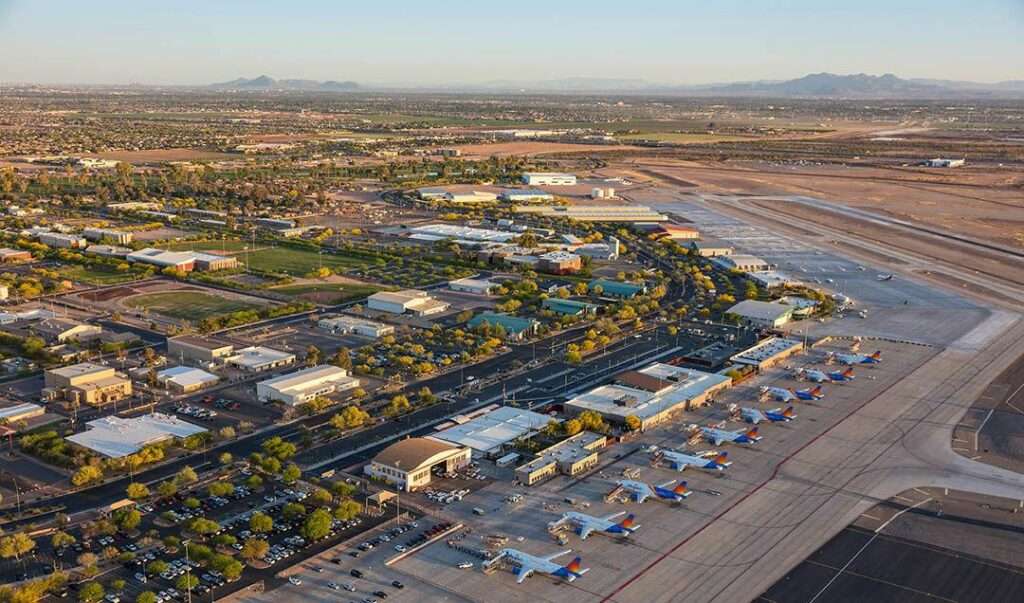Phoenix-Mesa Gateway Airport (AZA), nestled in the southeastern suburbs of Mesa, Arizona, boasts a surprisingly rich history.
Its journey began not with commercial airlines, but with the roar of military jets.
Let’s delve into the fascinating story of this airport, from its wartime origins to its current role as a vital hub for budget travel.
Taking Flight: The Williams Air Force Base Era (1948-1993)
The year was 1948.
The United States Air Force, seeking a new training facility in the dry, sunny climate of Arizona, established Williams Air Force Base on a vast swathe of desert land southeast of Mesa.
The base quickly became a center for pilot training, particularly for jet aircraft.
During the Cold War, Williams Air Force Base played a crucial role in national defense, churning out skilled aviators to defend the skies.
The base witnessed significant activity throughout the decades.
It housed various squadrons, including the 354th Fighter Squadron, known as the “Arizona Rattlers,” who flew iconic aircraft like the F-86 Sabre and F-100 Super Sabre.
During the Vietnam War, Williams Air Force Base served as a crucial training ground for pilots destined for Southeast Asia.
However, with the end of the Cold War and shifting military priorities, the need for Williams Air Force Base diminished.
In 1993, after nearly half a century of service, the base was deactivated.
The sprawling complex, with its runways and infrastructure, faced an uncertain future.
Transformation and Rebirth: The Phoenix-Mesa Gateway Airport Era (1994-Present)
The closure of Williams Air Force Base presented both a challenge and an opportunity.
Local communities in Mesa and Phoenix recognized the potential of the former base’s infrastructure.
In 1994, the Phoenix-Mesa Gateway Airport Authority was formed with a vision to transform the decommissioned military facility into a civilian airport.

The conversion process took several years.
The focus shifted from training military pilots to accommodating commercial airlines and private aviation.
The runways were modified for civilian use, and a new passenger terminal was constructed.
Finally, in 2004, Phoenix-Mesa Gateway Airport officially opened its doors to the public.
Initially, the airport catered primarily to general aviation and cargo operations.
However, a turning point arrived in 2007 when Allegiant Air, a low-cost carrier known for its budget-friendly fares, established Phoenix-Mesa Gateway Airport as a base for its expanding network.
This partnership proved to be a game-changer.
Allegiant Air’s presence attracted other budget carriers like Swoop and WestJet, transforming Phoenix-Mesa Gateway Airport into a major hub for discount travel.
The airport’s convenient location, ease of access, and focus on low-cost flights made it a popular choice for leisure travelers seeking affordable getaways.
Today, Phoenix-Mesa Gateway Airport boasts a steady stream of passenger traffic, serving over 1.7 million passengers in 2019.
It continues to expand its reach, offering nonstop flights to over 45 destinations across the United States and beyond.
A Look Ahead: The Future of Phoenix-Mesa Gateway Airport
The airport’s future appears bright.
The airport authority is committed to further development, including plans for additional terminal space and cargo facilities.
The growing popularity of budget airlines and the increasing demand for affordable travel bode well for the airport’s continued success.
However, challenges remain. Competition from the larger Phoenix Sky Harbor International Airport is a constant factor.
Additionally, the airport’s location, while convenient for some, can be less accessible for travelers in northern Phoenix or Scottsdale.
Despite these challenges, Phoenix-Mesa Gateway Airport’s unique history and focus on budget travel position it for continued growth.
As the Phoenix metropolitan area expands and the demand for affordable air travel rises, Phoenix-Mesa Gateway Airport is poised to play a vital role in connecting people to their destinations.
In conclusion, Phoenix-Mesa Gateway Airport’s story is one of adaptation and resilience.
From its military origins to its current role as a budget-friendly travel hub, the airport has continuously reinvented itself to meet the needs of the times.
As it looks towards the future, Phoenix-Mesa Gateway Airport promises to remain a significant player in Arizona’s aviation landscape.

Click the banner to subscribe to our weekly newsleter.

Click the photo to join our WhatsApp channel so then you can stay up to date with everything going on in the aviation industry!









